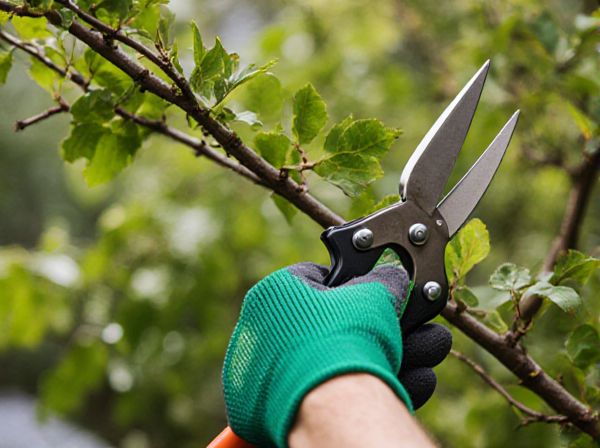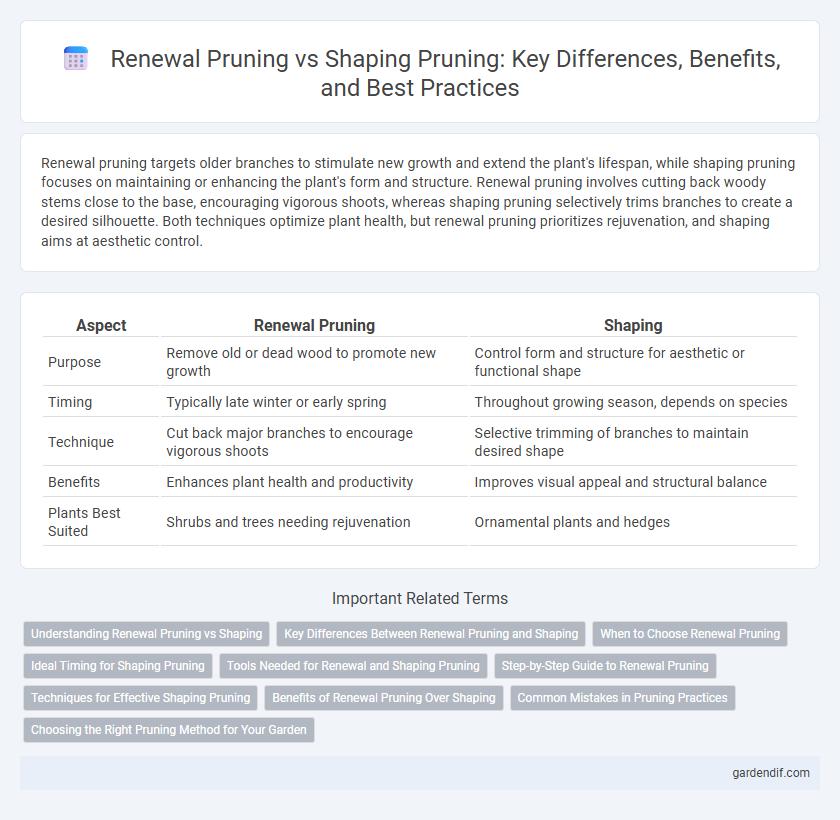
Renewal Pruning vs Shaping Illustration
Renewal pruning targets older branches to stimulate new growth and extend the plant's lifespan, while shaping pruning focuses on maintaining or enhancing the plant's form and structure. Renewal pruning involves cutting back woody stems close to the base, encouraging vigorous shoots, whereas shaping pruning selectively trims branches to create a desired silhouette. Both techniques optimize plant health, but renewal pruning prioritizes rejuvenation, and shaping aims at aesthetic control.
Table of Comparison
| Aspect | Renewal Pruning | Shaping |
|---|---|---|
| Purpose | Remove old or dead wood to promote new growth | Control form and structure for aesthetic or functional shape |
| Timing | Typically late winter or early spring | Throughout growing season, depends on species |
| Technique | Cut back major branches to encourage vigorous shoots | Selective trimming of branches to maintain desired shape |
| Benefits | Enhances plant health and productivity | Improves visual appeal and structural balance |
| Plants Best Suited | Shrubs and trees needing rejuvenation | Ornamental plants and hedges |
Understanding Renewal Pruning vs Shaping
Renewal pruning targets the removal of old or unproductive wood to stimulate vigorous new growth and extend the lifespan of plants, while shaping focuses on maintaining or enhancing the desired form by selectively trimming branches. Renewal pruning often involves cutting back entire stems to encourage fresh shoots, resulting in a healthier, rejuvenated structure. Shaping pruning emphasizes aesthetic form and balance, carefully refining the plant's silhouette without drastically altering its overall growth pattern.
Key Differences Between Renewal Pruning and Shaping
Renewal pruning involves selectively removing older branches to stimulate new growth and extend the life of a plant, enhancing its structural integrity and productivity. Shaping focuses on guiding the overall form and size by trimming outer growth to maintain aesthetic appeal and desired shape. The key differences lie in renewal pruning targeting plant health and vigor through removal of aged wood, while shaping emphasizes maintaining a specific silhouette and visual balance.
When to Choose Renewal Pruning
Renewal pruning is best chosen when an aging plant requires revitalization to stimulate new growth and improve overall health, often after several years of decline or diminished productivity. It targets the removal of old, unproductive branches to encourage a robust framework of fresh shoots. This technique is especially effective in fruit trees and shrubs needing rejuvenation before the growing season.
Ideal Timing for Shaping Pruning
Shaping pruning is ideally performed during early spring or late winter when trees and shrubs are still dormant, ensuring minimal stress and promoting vigorous new growth. This timing allows the plant to recover quickly and maintain its desired form throughout the growing season. Performing shaping pruning too late can expose fresh cuts to pests and diseases, reducing the effectiveness of the pruning process.
Tools Needed for Renewal and Shaping Pruning
Renewal pruning typically requires sharper tools such as pruning saws and loppers to remove older, woody growth and encourage vigorous new shoots. Shaping pruning often involves precision instruments like hand pruners and thinning shears to sculpt plants without causing extensive damage. Both techniques demand clean, well-maintained tools to promote healthy plant recovery and minimize disease risk.
Step-by-Step Guide to Renewal Pruning
Renewal pruning involves systematically removing older, less productive branches to stimulate vigorous new growth and improve plant health. Begin by identifying and cutting back individual stems close to the base, targeting those that are weak, damaged, or overcrowded to encourage regeneration. Follow with selective thinning of remaining branches to maintain structure, enhance light penetration, and promote balanced canopy development.
Techniques for Effective Shaping Pruning
Techniques for effective shaping pruning involve selective branch removal to maintain desired plant form and promote healthy growth. Focus on cutting back vigorous shoots while preserving structural branches to balance aesthetics and plant vitality. Consistent assessment of branch angles and growth patterns ensures precise shaping without compromising plant strength or renewal capacity.
Benefits of Renewal Pruning Over Shaping
Renewal pruning promotes vigorous regrowth by removing older, less productive branches, enhancing overall plant health and fruit yield compared to shaping. This method reduces long-term maintenance needs and prevents structural weaknesses that can arise from merely shaping the plant. By stimulating new shoots and improving air circulation, renewal pruning supports sustained plant vigor and resilience against pests and diseases.
Common Mistakes in Pruning Practices
Renewal pruning often suffers from the common mistake of removing too much mature wood at once, which can stress the plant and reduce its vigor. In shaping pruning, a frequent error is cutting back growth indiscriminately, leading to an unbalanced structure and weak branch formation. Both practices require precise timing and selective cuts to promote healthy regrowth and maintain plant architecture.
Choosing the Right Pruning Method for Your Garden
Renewal pruning targets older, overgrown plants by cutting back to promote vigorous new growth, ideal for revitalizing shrubs and maintaining health. Shaping pruning, in contrast, focuses on controlling size and form, enhancing the aesthetic appearance without drastic removal. Choosing the right method depends on the plant's age, health, and your garden's design goals, ensuring optimal growth and visual appeal.
Renewal Pruning vs Shaping Infographic

 gardendif.com
gardendif.com